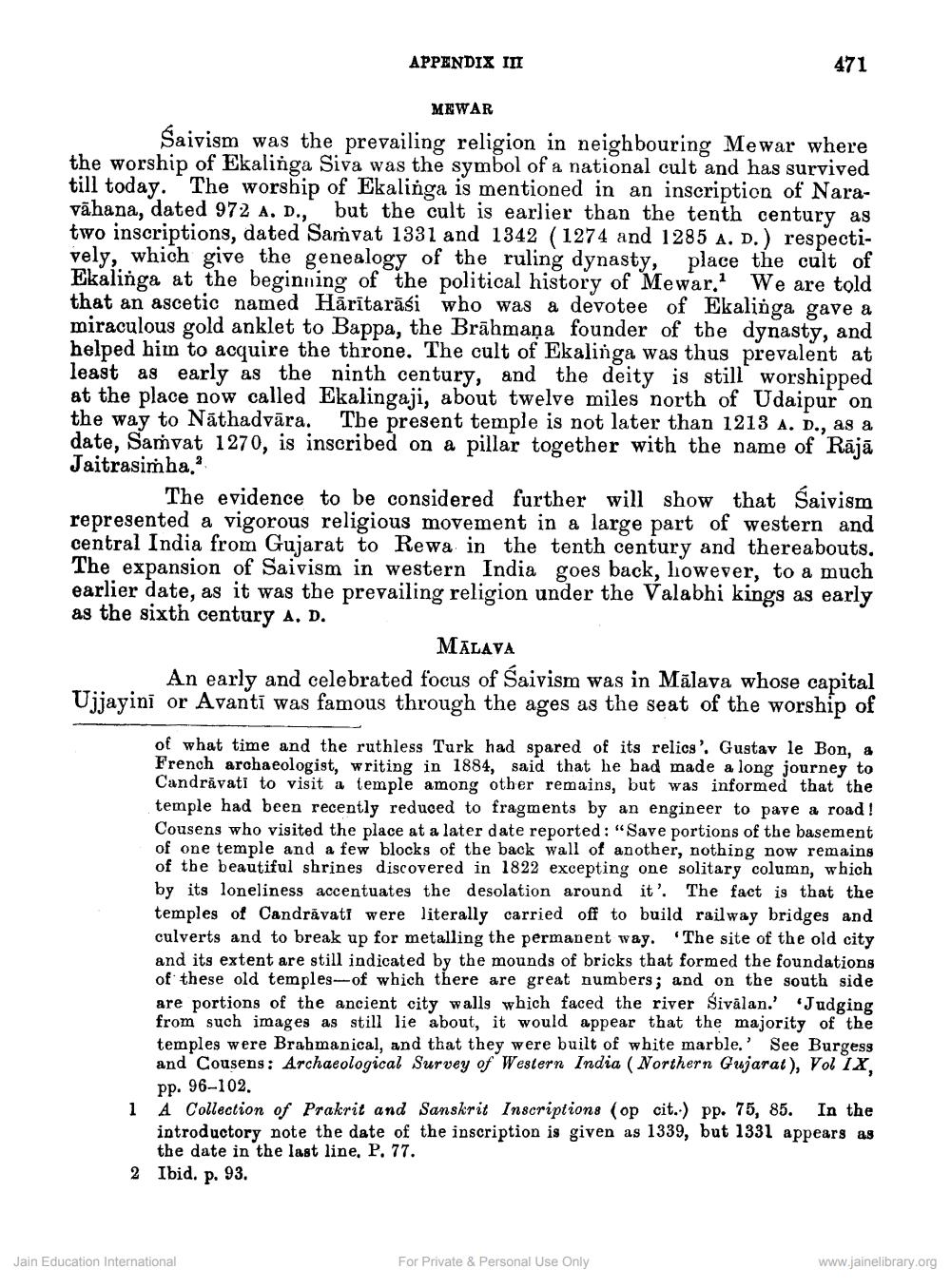________________
APPENDIX III
471
MEWAR Saivism was the prevailing religion in neighbouring Mewar where the worship of Ekalinga Siva was the symbol of a national cult and has survived till today. The worship of Ekalinga is mentioned in an inscription of Naravāhana, dated 972 A. D., but the cult is earlier than the tenth century as two inscriptions, dated Samvat 1331 and 1342 (1274 and 1285 A. D.) respectively, which give the genealogy of the ruling dynasty, place the cult of Ekalinga at the beginning of the political history of Mewar. We are told that an ascetic named Hārītarāśi who was a devotee of Ekalinga gave a miraculous gold anklet to Bappa, the Brāhmaṇa founder of the dynasty, and helped him to acquire the throne. The cult of Ekalinga was thus prevalent at least as early as the ninth century, and the deity is still worshipped at the place now called Ekalingaji, about twelve miles north of Udaipur on the way to Nāthadvāra. The present temple is not later than 1213 A. D., as a date, Samvat 1270, is inscribed on a pillar together with the name of Rājā Jaitrasimha.
The evidence to be considered further will show that saivism represented a vigorous religious movement in a large part of western and central India from Gujarat to Rewa in the tenth century and thereabouts. The expansion of Saivism in western India goes back, however, to a much earlier date, as it was the prevailing religion under the Valabhi kings as early as the sixth century A. D.
MĀLAVA An early and celebrated focus of Saivism was in Mālava whose capital Ujjayini or Avanti was famous through the ages as the seat of the worship of
of what time and the ruthless Turk had spared of its relics'. Gustav le Bon, a French archaeologist, writing in 1884, said that he had made a long journey to Candrăvati to visit a temple among other remains, but was informed that the temple had been recently reduced to fragments by an engineer to pave a road! Cousens who visited the place at a later date reported : "Save portions of the basement of one temple and a few blocks of the back wall of another, nothing now remains of the beautiful shrines discovered in 1822 excepting one solitary column, which by its loneliness accentuates the desolation around it'. The fact is that the temples of Candrivati were literally carried off to build railway bridges and culverts and to break up for metalling the permanent way. The site of the old city and its extent are still indicated by the mounds of bricks that formed the foundations of these old temples-of which there are great numbers; and on the south side are portions of the ancient city walls which faced the river Sivālan.' Judging from such images as still lie about, it would appear that the majority of the temples were Brahmanical, and that they were built of white marble.' See Burgess and Cousens: Archaeological Survey of Western India (Northern Gujarat), Vol IX pp. 96-102. A Collection of Prakrit and Sanskrit Inscriptions (opcit.) pp. 75, 85. In the introductory note the date of the inscription is given as 1339, but 1331 appears as the date in the last line, P. 77. Ibid. p. 93.
1
2
Jain Education International
For Private & Personal Use Only
www.jainelibrary.org




